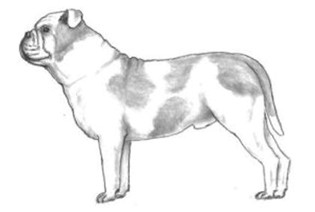Breed standards
Australasian Bosdog
Breed standards are the official guidelines that describe the ideal characteristics, temperament, and appearance of a breed and ensures that the breed is fit for function with soundness essential.

Australian National Kennel Council
Effective from 1 January 2022
Country of Origin: Australia
The Australasian Bosdog is a short faced, smooth coated, thickset, medium sized dog with a powerful build showing strength and agility. An Australasian Bosdog is sound and active. Bitches generally not so grand or well developed as dogs.
Conveys impression of strength, activity and stamina and exhibits a trustworthy and enduring disposition.
Loyal, fierce in appearance, but extremely outgoing and affectionate in nature. Very stable and predictable. Enjoys activity, however a lot of exercise is not necessary for health and mental stability. The breed craves human attention. Some may not tolerate aggressive overtures by other dogs.
The head should be large, but not exaggerated out of proportion to the body. Broad muzzled and short faced, but the nose should be long enough for unhindered breathing. Muzzle is broad and turning up. Muzzle length from tip of nose to stop to be no less than 35mm and no more than 45mm. The forehead is flat to slightly domed. Loose folds of skin across nose, but in no way excessively wrinkled. Nostrils big and wide open. Nose any colour acceptable. Head circumference should be equal to body height or up to 15% larger for males and equal or up to 10% larger for females.
Eyes are round, set low and wide, never bulging or sunken – preferably without visible haw. Eyes of any colour acceptable including blue.
Small to moderate size. Set wide apart. Never erect or cropped. A folding ear is preferred, rose ear acceptable.
Broad jaw. Canines set wide apart. Well occluded incisors. Complete dentition required. Flews are relatively broad and hanging over lower jaw at each side. Teeth should not be obviously protruding. Flews should notbe excessive in size and mouth should not be excessively loose.
Moderate in length; thick, deep and strong with loose skin forming dewlap on either side. Neck not so short as to give the impression that the head sits directly on the shoulders.
Chest wide and deep. Well laid back shoulders. Elbows held slightly away from ribs.
Shoulders broad, but not excessively so, rounded ribs. Forelegs powerful and straight, not bandy or curved, well boned, set wide apart presenting a straight front. Pasterns straight and strong.
Back short and straight giving compact carriage, but not so short as to interfere with activity and agility. Bitches may have greater body length than males in order to assist natural whelping. Body shape in general is brick shaped with shoulders only slightly wider than hips.
- Body length for males should be equal to height or up to 10% longer.
- Body length for females should be between 10% and 20% longer than height.
Strong and muscular. Hip width should be no more than 15% narrower than the shoulders. Thelegs are not markedly longer than forelegs. Hocks well angulated, neither turning inwards nor outwards. Hind legs powerfully muscled with well let down hocks, a distinct turn of stifle.
Compact, strong and straight. Short toes, well split up. Excessively splayed feet undesirable.
Thickset at root. Straight (long or short). Crank tail acceptable. Screw tails undesirable.
Free flowing moving true fore and aft with plenty of drive.
Smooth, short, tight to body.
Brindle, Fawn, Red, Tan, White. Pied of any of these colours.
Height: Dogs 45-50cm
Height: Bitches 44-48cm
Weight: Dogs 30-35kg
Weight: Bitches 26-29kg
Any departure from the foregoing points should be considered a fault and the seriousness with which the fault should be regarded should be in exact proportion to its degree and its affect upon the health and welfare of the dog.
Male animals should have two apparently normal testicles fully descended into the scrotum.



